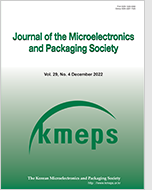
Search
- Past Issues
- e-Submission
-

KCI Accredited Journals KCI 등재지
KCI Impact Factor 0.54
Editorial Office
- +82-2-538-0962
- +82-2-538-0963
- kmeps@kmeps.or.kr
- http://kmeps.or.kr/

KCI Accredited Journals KCI 등재지
KCI Impact Factor 0.54
Journal of the Microelectronics and Packaging Society 2024;31(4):47-56. Published online: Jan, 22, 2025
DOI : doi.org/10.6117/kmeps.2024.31.4.047
AI 알고리즘의 복잡성 증가로 고대역폭 메모리에서 실리콘 관통전극(through silicon via, TSV) 공정의 중요성이 부각되고 있다. 대표적인 TSV 형성 공정은 습식 식각과 건식 식각으로 나뉘며, 건식 식각 중 DRIE(deep reactive ion etching) 공정은 포토리소그래피(photolithography) 공정이 필요하고 스캘럽(scallop)모양 형성으로 인한 표면 거칠기 문제가 발생하는 단점이 있다. 반면, 레이저 드릴링(laser drilling)은 포토리소그래피 공정 없이 고종횡비 구현이 가능하다. 특히, 펨토초 레이저는 나노초 레이저에 비해 비열적 가공이 가능해 정밀한 가공에 유리하다. 그러나 펨토초 레이저의 단일 펄스 모드(single pulse mode)를 사용하여 비아홀(via hole)을 형성할 경우, 홀 내벽에 재응고층(recast layer), 잔여물(debris), 레이저 유도 주기적 표면 구조(laser induced periodic surface structures, LIPSS)가 형성되어 표면 거칠기가 증가한다. 이러한 거칠기는 도금 공정에서 도금성을 저하시키며, 전기 신호 전달 시 노이즈 증가와 성능 저하를 초래하게 된다. 본 연구는 펨토초 레이저의 버스트 모드(burst mode)를 활용하여 재응고층, 잔여물, LIPSS 생성을 제어함으로써 비아홀 가공의 최적 공정 조건을 제시하고자 한다.
Keywords Femtosecond laser, Burst mode, Sidewall roughness, LIPSS control, Through silicon via